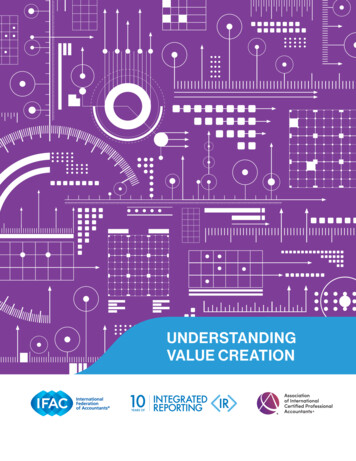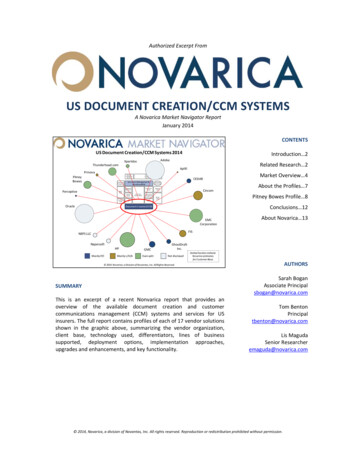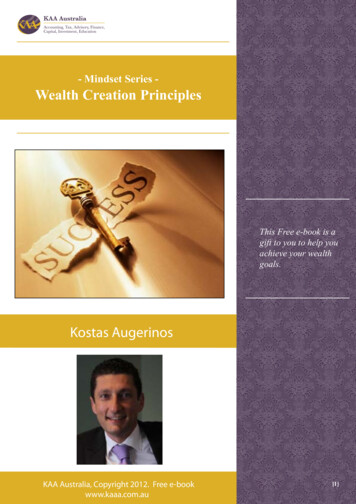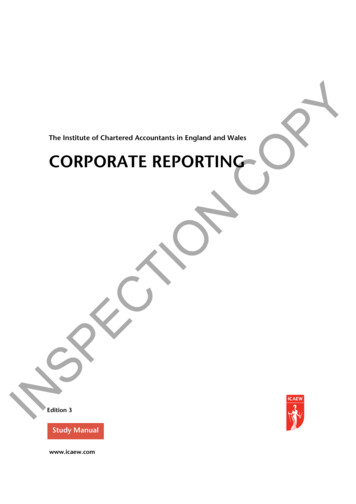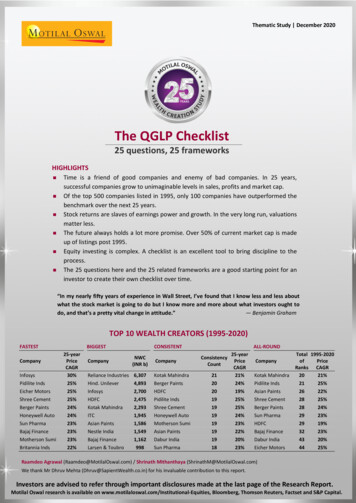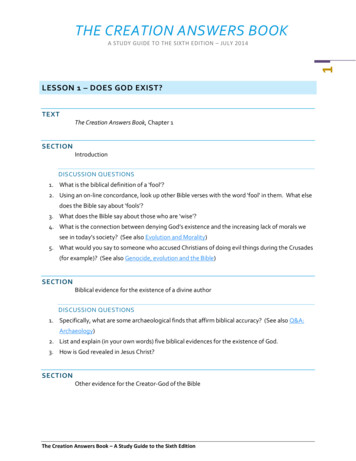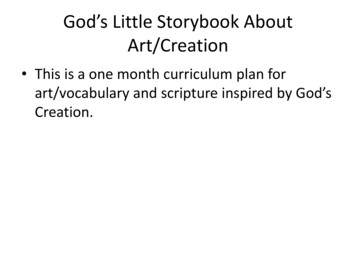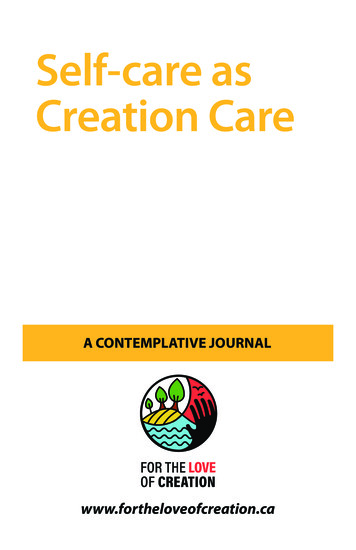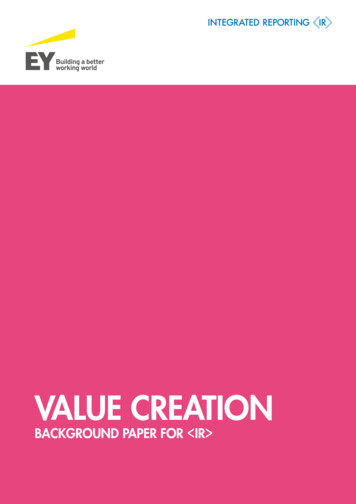
Transcription
VALUE CREATIONBACKGROUND PAPER FOR IR 1
The Technical Task Force of the International Integrated Reporting Council(IIRC) established a Technical Collaboration Group (TCG) to prepare thisBackground Paper for IR . The TCG was coordinated by the leadorganizations with input from participants from a range of disciplines andcountries. This paper reflects the collective views of TCG participants, notnecessarily those of their organizations or the IIRC.The IIRC considered interim findings from the TCG when preparing thePrototype Framework released in November 2012, and considered aspects ofthis paper in developing its Consultation Draft of the International IntegratedReporting ( IR ) Framework.The IIRC gratefully acknowledges the contributions made by the following inthe drafting of this Background Paper for IR :LEAD ORGANIZATIONErnst & Young LLP (EY)STEERING COMMITTEESusan Blesener, The Art of ValuePedro Faria, CDPJonathan Hanks, Incite SustainabilityRowland Hill, Marks & SpencerBob Massie, New Economics InstituteDavid Matthews, KPMGTom Rotherham, Hermes EOSRichard Spencer, ICAEWFraser Thompson, McKinseyAlan Willis, CICA/IndependentJoanne Westwood, Vancouver City Savings Credit Union (Vancity)Roger Simnett, University of New South WalesLois Guthrie, International Integrated Reporting CouncilMatthew Bell, EY (Australia)Meg Fricke, EY (Australia)Brendan LeBlanc, EY (United States)Benjamin Miller, EY (Canada)Kelly Gilman, EY (South Africa)Copyright July 2013 by the International Integrated Reporting Council. All rightsreserved. Permission is granted to make copies of this work to achieve maximumexposure provided that each copy bears the following credit line: Copyright July2013 by the International Integrated Reporting Council. All rights reserved. Used withpermission of the International Integrated Reporting Council. Permission is granted tomake copies of this work to achieve maximum exposure.ISSN: 2052-17232
CONTENTS1Executive Summary2About this Background Paper for IR 31. Introduction32. Overview of the term “value creation”93. Value creation for IR purposes93A Explaining value creation for IR 113B Who assesses value for IR purposes?124. Information that enables readers and users of integrated reports to assessvalue creation124A Information that facilitates an assessment of value creation134B Practical limitations to the communication of value creation155. Examples of communication about value creation16Conclusion
Value CreationBackground Paper for IR Executive SummaryThis Background Paper for IR explores the concept of value creation for Integrated Reporting IR purposes.Integrated Reporting IR is a process that results in communication, most visibly a periodic “integrated report”about value creation over the short, medium and long term1. The concept of value creation therefore lies at theheart of IR .The International Integrated Reporting Council (IIRC) has developed a draft International IR Framework (thedraft IR Framework) in order to encourage the transition to IR . Together with the business model andcapitals, value creation is one of the three fundamental concepts identified as underpinning the requirementsand guidance set out in the draft IR Framework.Although organizations aim to create value overall, resources and relationships, also referred to in the draft IR Framework as different types of “capital”, may be destroyed or depleted in the process of conductingbusiness activities. Therefore, whenever the term “value creation” is used, it should be interpreted to includeactual or potential value destruction or depletion2.Value is created, changed or destroyed by an organization through its business model. The Business ModelBackground Paper for IR defines the term business model as “the chosen system of inputs, business activities,outputs and outcomes that aims to create value over the short, medium and long term.” Therefore, within thecontext of IR , the process of value creation is explained as follows:Value is created through an organization’s business model, which takes inputs from the capitals and transformsthem through business activities and interactions to produce outputs and outcomes that, over the short, medium andlong term, create or destroy value for the organization, its stakeholders, society and the environment.The capitals from which the business model takes inputs are identified in the Capitals Background Paper for IR as financial, manufactured, intellectual, human, social and relationship, and natural capital. The capitalsrepresent stores from which value is released when the capitals are combined, transformed and leveragedthrough an organization’s business activities and interactions in order to produce outputs and outcomes thatrepresent value creation or value destruction for stakeholders depending on their interests and perspectives.The process of taking inputs of capital and applying, using, combining, transforming and sometimes destroyingthem through the business model to produce outputs and outcomes has both positive and negative effectsindividually and collectively on the capitals, on the organization, providers of its financial capital, society andthe environment. The nature of those effects informs an assessment of whether, to what extent, for whom andover what timescales value has been created. This in turn depends in part on the outcomes from the businessmodel for the environment and for consumers and other stakeholders affected by the organization’s activities(e.g., competitors, regulators and local communities).The assessment of value creation therefore involves considering the interdependencies between a company’scompetitiveness and performance and the communities, stakeholders, supply chains and natural environment itaffects and on which it draws. An integrated report should enable providers of financial capital to assesswhether, to what extent and how an organization’s business model affects the wider context that supports orthreatens value creation, including financial value, in the short, medium and long term.12www.theiirc.orgThe Capitals Background Paper for IR footnote 7 page 41
About this Background Paper for IR This Background Paper for IR is organized into five sections as follows:Section 1 introduces the paper.Section 2 provides an overview of some of the theory that informs the meaning of the term value creation.Section 3 explains the process of value creation for IR purposes.Section 4 considers the type of information that is likely to help readers and users of integrated reports to assesswhether, to what extent and for whom value has been created and can continue to be created over the short,medium and long term.Section 5 illustrates practice on communicating value creation based on extracts from reports published byselected members of the IIRC’s Business Network.2
1. Introduction1 The IIRC’s September 2011 Discussion Paper, “Towards Integrated Reporting – Communicating Value in the21st Century” said that IR “provides a clear and concise representation of how an organization createsvalue now and in the future.”2 In response to the 2011 Discussion Paper 73% of respondents agreed, (2% of whom agreed withqualifications), that the ability of an organization to create and sustain value over the short, medium and longterm is appropriate as a central theme for the future direction of reporting3. The concept of value creation hastherefore been retained in the Consultation Draft of the International IR Framework (the draft IR Framework) as one of the three fundamental concepts underpinning the requirements and guidance set out inthe draft IR Framework.The scope of this Background Paper for IR 3 This Background Paper for IR responds to questions and comments that were raised in response to andsince publication of the 2011 Discussion Paper, in particular the need for more clarity about the term valuecreation for IR purposes, to whom value accrues for IR purposes and how value should be communicatedin an integrated report. This Background Paper provides a blend of theory and practical examples intended toexplain the concept of value creation. The information contained in this Background Paper is neither exhaustivenor authoritative. Like the draft IR Framework itself, this Background Paper does not prescribe an ideal oruniversally applicable approach to communicating value creation. Rather, it sets out theories and examples thatcan be used by organizations to tailor their communication of value creation to their own circumstances,reporting needs, objectives and audiences.4 The explanation of value creation in this Background Paper should be distinguished from the meaning ofvalue. This Background Paper does not define value. Value has different meanings for different people and indifferent contexts and those meanings and contexts are not explored here. This Background Paper focuses onexplaining the process of value creation for IR purposes.5 Certain matters that are associated with the concept of value creation are not addressed in this BackgroundPaper as they represent on-going bodies of research in their own right, which are beyond the scope of thispaper. For example, the paper does not cover in detail the debate about whether and to what extent the role ofthe modern corporation is to maximize shareholder value or to create value for the whole of society, nor does itexamine creation of intrinsic and extrinsic value. Furthermore, this Background Paper does not seek to reconcilevalue creation for IR purposes with other concepts of value such as enterprise value, total economic value,economic value added and total value. Finally, whilst it is recognized that notions of value capture and valueappropriation are closely linked to the concept of value creation, the IIRC’s work focuses on value creation. Anexamination of the way in which and by who or what created value is captured or appropriated is thereforebeyond the scope of this paper.2. Overview of the term “value creation”6 Value creation is a widely used term. Calls for business reporting to focus more on factors, including nonfinancial factors, that create longer-term value date back some years. For example, a Special Committee onFinancial Reporting established by the American Institute of Certified Public Accountants in 1991 recommendedthat the information companies should provide to investors and creditors should “focus more on the factors thatcreate longer term value4.”7 Although there is no universally agreed definition of the term value creation or the manner in which it shouldbe communicated, certain themes inform the meaning of the term generally. The following general themes aboutvalue creation emerge from the literature review conducted to support the development of this BackgroundPaper for IR . The ten themes identified in this Background Paper do not represent a comprehensive list of allmatters that influence the way in which value creation may be ttee.aspx3
Ten themes that inform the meaning of value creationValue creation takes place within a contextFinancial value is relevant, but not sufficient, for assessing value creationValue is created from tangible and intangible assetsValue is created from private and public/common resourcesValue is created for an organization and for othersValue is created from the connectivity between a wide range of factorsValue creation manifests itself in outcomesInnovation is central to value creationValues play a role in how and what type of value is createdMeasures of value creation are evolving8 The themes are explored below, by way of context for Section 3, which explains the process of value creationfor IR purposes. Each theme represents a major body of research in its own right. This Background Paper for IR summarizes elements of the research by way of general background only. The themes are numbered forease of cross-referencing in this Background Paper for IR . The numbering does not imply any order or priorityto the themes that have been identified during the literature review.1. Value creation takes place within a context9 Value is created by organizations from a wide range of interactions, activities, relationships, causes andeffects5. Those interactions take place in the market, regulatory, societal and natural/environmental contextwithin which the organization operates and on which it depends. The interactions occur between theorganization and its consumers, employees, stakeholders, regulators, suppliers and others operating in thecontext within which an organization conducts business activities. The context is also affected by natural,environmental and planetary limits.10 A report by WWF and SustainAbility states that “the Earth cannot keep up with the demand our economy isplacing on its ecological assets. Evidence is mounting that the sheer volume of resources flowing through theglobal economy has become today’s key environmental challenge and as human demand for resources grows,the Earth’s life supporting natural capital will be liquidated at ever-increasing rates6.”11 The context and interactions within it therefore affect the degree to which and the type of value that can becreated. For example, the context affects and to some extent determines: The type, cost and extent of resources that are available to an organization as inputs to the business modelfor the creation of value. The types of risk and opportunity, including their nature, timing, potential impact and uncertainties7 thatactually or potentially affect the organization’s ability to create value. The risks to which organizations areexposed are examined in various reports including the World Economic Forum’s Global Risk reports8. The way in which value is perceived based on societal expectations of what represents value creationby an organization. For example, research by EABIS concludes that sustainable development goalshave challenged the existing dominant convention of shareholder value and of how value is created ordestroyed9.Consultation Draft of the International IR Framework paragraph 2.37One Planet Business – Creating Value within Planetary Limits, WWF and SustainAbility, 2007Tomorrow’s Company and CIMA - “Tomorrow’s s9Outcomes from business activities are externalized where the costs or benefits associated with the production or consumption of goods and services areimposed on and experienced by others outside the organization but are not reflected in the prices charged for goods and services.5674
12 The assessment of whether and to what extent value has been created therefore takes account of contextualfactors including: resource scarcity, the increasing connectivity of the globalized world and the way in whichcertain outcomes from business activity spill over into the environment, are “externalized” and are perceived bysociety.According to the Organization for Economic Cooperation and Development (OECD), “externalities refers tosituations when the effect of production or consumption of goods and services imposes costs or benefits onothers which are not reflected in the prices charged for the goods and services being provided.Pollution is an obvious example of a negative externality. Chemicals dumped by an industrial plant into a lakemay kill fish and plant life and affect the livelihood of fishermen and farmers nearby.In contrast, a positive externality or external economy may arise from the construction of a road which opens anew area for housing, commercial development, tourism, etc. The invention of the transistor generatednumerous positive externalities in the manufacture of modern telecommunication, stereo and computerequipment. Externalities arise when property rights cannot be clearly assigned.11”13 According to paragraph 2.44 of the draft IR Framework, “ IR takes account of the extent to whicheffects on the capitals have been externalized (i.e., the costs or other effects on the capitals that are not ownedby the organization). Externalities may be positive or negative (i.e., they may result in a net increase ordecrease to the value embodied in the capitals).”2. Financial value is relevant, but not sufficient, for assessing value creation14 Financial value may be manifested in various ways, including in an organization’s stock price, profits,balance sheet and organizational growth, and it may change over different timeframes. According toMcKinsey, companies create value by investing capital from investors to generate future cash flows at rates ofreturn exceeding the cost of that capital (i.e., the rate investors require to be paid for the use of their capital).“The faster companies can grow their revenues and deploy more capital at attractive rates of return, the morevalue they create. In short the combination of growth and [return on investment capital] drives value and valuecreation12.”15 However, recent analyses challenge the narrow focus of value creation on financial value and contend thatvalue creation extends beyond benefits directly associated with financial value or financial capital accretion.Although relevant, it is not sufficient to assess value creation only through the process of exchange in marketswhich sets prices and expresses the quantified worth of goods and services or through accounting concepts ofvalue expressed in profit and loss statements, balance sheets and organizational growth.16 As well as value that may be quantified in financial terms, value may be also be manifested in utility value,that is the qualitative aspect of value: value in the eyes of consumers and users through its utility in meetinghuman needs. Utility value is expressed and realized through its consumption. Utility, that is the customer orstakeholder’s assessment of worth, is not derived from a single source but from three overlapping areas:functional utility (what the product or service does), economic utility (how much it costs) and emotional utility(how it makes the customer feel)13.17 Similarly Benedickt, Oden14and Herman Daly15 refer to value being manifested in “qualitative growth”,being the increase in the quality of goods and outcomes produced by an economy rather than an increase inthe quantity of goods and services, whilst offering the same or greater opportunities for profitable investment,full employment and decent wages.OECD Glossary of Statistical Terms accessed 5 February 2013 from .com/client service/corporate finance/latest thinking/value/the four cornerstones“What does value mean and how is it created, maintained and destroyed?” – C Bowman and V Ambrosini, Cranfield School of Management, 200314Better is Better than More M Benedikt and M Oden, Centre for Sustainable Development Working Paper Series 2011 (0115Beyond Growth: The Limits of Sustainable Development, Herman Daly, Boston:Beacon Press 19961112135
3. Value is created from tangible and intangible assets18 Tangible assets have a physical form and existence. By contrast, intangible assets do not have a physicalpresence. In International Accounting Standard (IAS) 38, the International Accounting Standards Board (IASB)defines them as non-monetary assets, which are without physical substance. Intangible assets include brands,patents, goodwill, know-how, reputation, the knowledge held by employees and the corporate strategy.Intangible assets contribute to the creation of value by organizations.19 Increasingly value is created primarily from intangible rather than physical assets16. For example, 280 chiefexecutive officers from over 21 countries surveyed by the AICPA and CIMA concluded that people’s ideas,skills, knowledge and relationships represented the unique value of their companies in terms of where it comesfrom and how much of it is available. They therefore supported the need to measure and manage the humandimension in order to achieve long-term sustainable success17. Intangible assets, such as good reputation, havebeen described as “critical, because of their potential for value creation and also because their intangiblecharacter makes replication by competing firms considerably more difficult18.”20 Although intangible assets are recognized for the purposes of valuing organizations, there is no standardmethod of accounting for them, as there is for physical assets19. In many cases they are not reflected on thebalance sheet despite contributing to the future success of the company20. Arguably this makes financialaccounting incomplete and contributes to the widening gap between book and market value referred to, forexample, in the Sonecon publication, “What Ideas are Worth: The Value of Intellectual Capital and IntangibleAssets in the American Economy21.” The Sonecon publication concludes that for ten industries it examined,intangible assets represent at least 90% of market, not book, value. The “value gap” between market value andbook value indicates that physical and financial accountable assets reflected on a company’s balance sheetcomprises less than 20% of the true value of the average firm.21 Given their contribution to value creation, some argue that “in order to assist managers of businessenterprises and their providers of capital in their decision-making processes. guidelines [should be developed]for the identification of intangible [assets and for the] measurement and successful management of intangibleswithin.22” organizations. Many therefore call for measurement, reporting and management of all of the assets,tangible and intangible, that affect the ability of an organization to create value.4. Value is created from private and public/common resources22 In some cases an organization does not own or bear a direct charge for their use of, or effect on, sources ofcapital that are input to the business model to transform into outputs and outcomes that create value. Suchsources of inputs are often known as the “global commons” or “common pool resources” – terms that refer toresources that are unowned, unprivatized, unregulated, free and shared by all. These include the oceans andthe atmosphere and the environmental goods and services that they provide, as well as societal assets such aspublic road networks.23 Garrett Hardin’s “Tragedy of the Commons23” recognizes that the value of the commons for one actor inorder to maximize or capture his gain can result in negative effects that are shared by all. For example, if thecost of discharging waste into the commons is less than the cost of purifying the waste before releasing it, thepolluter will gain (or capture value) but society will bear the consequences and costs of the effects of the wasteon the commons. Such consequences and costs are known as “externalities” (see theme 1 above). Externalitiesmay impact on both private and public/common resources. Various solutions have been proposed to managecommon resources and deal with externalities, including government intervention, allocation of property rightsand the development by communities of their own rules and methods of enforcement24.Rebooting Business: Valuing the Human Dimension, Chartered Global Management Accountant, a joint venture between the AICPA and CIMACorporate Reputation and Sustained Superior Financial Performance, Peter W Roberts & Grahame R DowlingAccounting for Intangibles: Financial Reporting and Value Creation in the Knowledge Economy - A Research Report for the Work Foundation’s KnowledgeEconomy Programme by Ricardo Blaug and Rohit Lekhi, Research Republic LLP20The Value Relevance and Managerial Implications of Intangibles - Leandro Canibano, Manuel Garcia-Ayuso Covasi and M Paloma Sanchez, March 199921http://www.sonecon.com/docs/studies/Value of Intellectual Capital in American Economy.pd22The Value Relevance and Managerial Implications of Intangibles - Leandro Canibano, Manuel Garcia-Ayuso Covasi and M Paloma Sanchez, March 199923Science, New Series, Vol 162, No 3859 (Dec 13, 1968)24The Future of the Commons; Beyond Market Failure and Government Regulation - Elinor Ostrom with contributions from Christina Chang, Mark Penningtonand Vlad Tarko - A report for the Institute of Economic Affairs, 20121718196
24 All solutions for managing the commons are dependent upon transparency, information and commonlanguage. This is because, in order to manage and preserve their value creating potential, decision-makersneed information about the nature of the common resources, the incentives and disincentives facing actual andpotential resource users, the scientific and technological variables that affect common resources and so on.5. Value is created for an organization and for others25 Some of the literature on value creation reviewed for this Background Paper refers to the dichotomy betweentwo views of the constituencies for which an organization creates value. The first, often known as “shareholdervalue theory”, is widely attributed to Milton Friedman in 1962. Friedman’s view declares the purpose of acompany as being to maximize shareholder value and to pursue social activities only as long as they generateprofit. The second view, attributed to Edward Freeman in the 1980s, is often known as stakeholder theory andstates that the objective of organizations should be to augment the greater good for the many and to create asmuch value as possible for multiple stakeholders. The question therefore arises as to whether value should becreated for shareholders or for multiple stakeholders or for both.26 In Michael Jensen’s report “Value Maximization, Stakeholder Theory and the Corporate ObjectiveFunction”, Jensen states that business should get the most out of society’s limited resources, while returninggreater value to society so that the pursuit of stakeholder value and a healthy environment helps a business tomaximize its financial value. The implication of Jensen’s work is that the interests of shareholders andstakeholders are not at odds. Jensen states that any potential conflicts between them should be resolved througha focus on long-term value creation, as the long term value of a company “cannot be maximized if anyimportant constituency is ignored or mistreated. We cannot create value without good relations with customers,employees, financial backers, suppliers, regulators, communities and so on25.”27 Increasingly, value creation is understood in terms of the value that is appropriated to the organization fromits business activities and the value that is created for and captured by others. In “Creating Shared Value”Michael E. Porter and Mark R. Kramer define shared value as “creating economic value in a way that alsocreates value for society by addressing its needs and challenges”. They describe shared value as “a conceptthat focuses on the connections between societal and economic progress and that expands the total pool ofeconomic and social value”. Shared value is based on the premise that having environmental or social issuesthat are not addressed creates internal costs for companies (e.g., wasted energy, remedial training tocompensate for inadequate education systems), which constrain the extent of value creation, destroy value or,over the longer term, make the business model unsustainable.28 As well as being created for and captured by a wide range of stakeholders, value is increasingly created incollaboration with others, including consumers who “armed with new tools and dissatisfied with availablechoices. want to interact with firms and thereby co-create value26.”6. Value is created from the connectivity between a wide range of factors29 The assessment of value creation is based on a “compound vector of qualitative, ethical, social, aestheticand practical27” factors, the way in which they interact and the outcomes of those interactions for multiplestakeholders. As Edward Freeman notes, “no stakeholder stands alone in the process of value creation28.”Therefore, communicating value creation is not simply a question of merging financial and non-financialinformation. As Ernst & Young observes29, a comprehensive picture of value creation is communicated throughalignment between many factors including business practices, tangible and intangible assets, material financialand non-financial capital risks, the company’s strategy, its engagement with multiple stakeholders, sustainabilityagenda, governance practices and future goals over the short, medium and long term. Communicating valuecreation also involves describing the trade-offs between the various interdependencies on which the valuecreation process depends, such as between equity and advantage and quality over quantity30.Value Maximization, Stakeholder Theory and the Corporate Objective Function, Michael C. Jensen, HBS Working Paper, April 2000Co-creation Experiences: The next practice in value creation - C.K. Prahalad and Venkat Ramaswamy. Published in the Journal of Interactive Marketing,Volume 18, Number 3, Summer 200427Better is Better than More JS Mills28The Journal of Business Ethics 2010 96:7-9, R. Edward Freeman - Managing for Stakeholders: Trade offs or Value Creation29Insights for Executives - Driving value by combining financial and non-financial information into a single investor grade document30Speth (2008) quoted in Better is Better than More25267
30 It is beyond the scope of this Background Paper for IR to examine the different approaches to thepotential trade offs that are required to create value. However, Michael Jensen’s work31 is one example thatrecognizes the conceptual difficulty of making trade-offs between the various interdependent factors anddifferent stakeholders that contribute to or are affected by business activitie
1 Value Creation Background Paper for IR Executive Summary This Background Paper for IR explores the concept of value creation for Integrated Reporting IR purposes. Integrated Reporting IR is a process that results in communication, most visibly a periodic "integrated report" about value creation over the short, medium and long term1.The concept of value creation therefore lies at the
